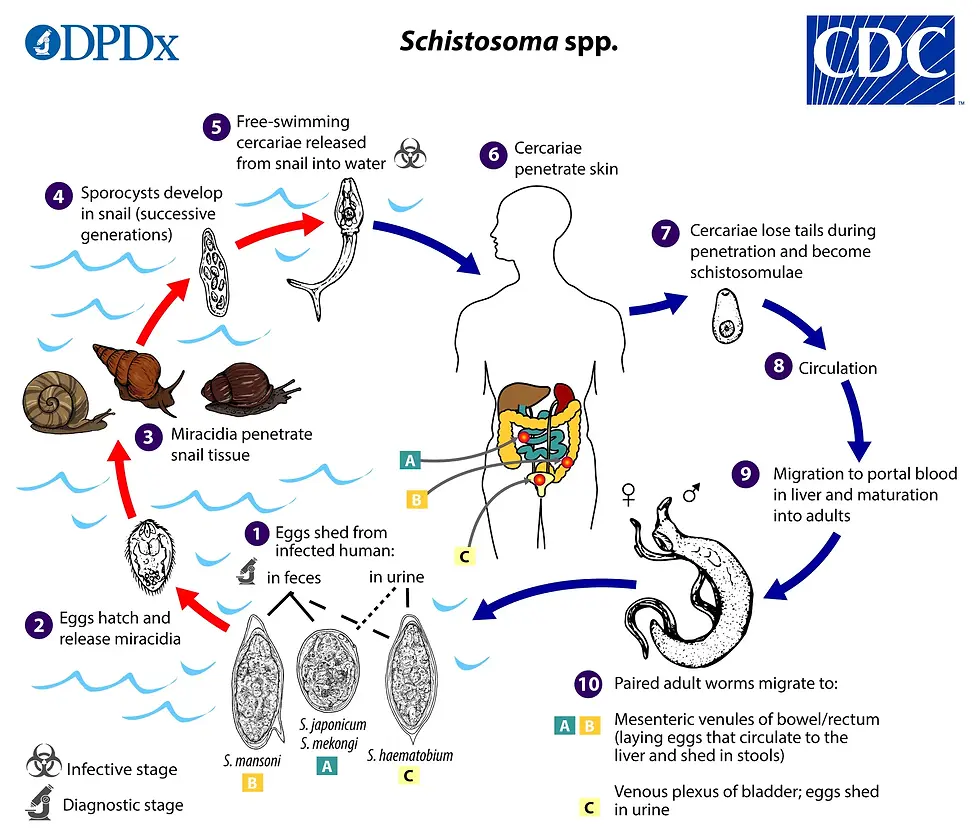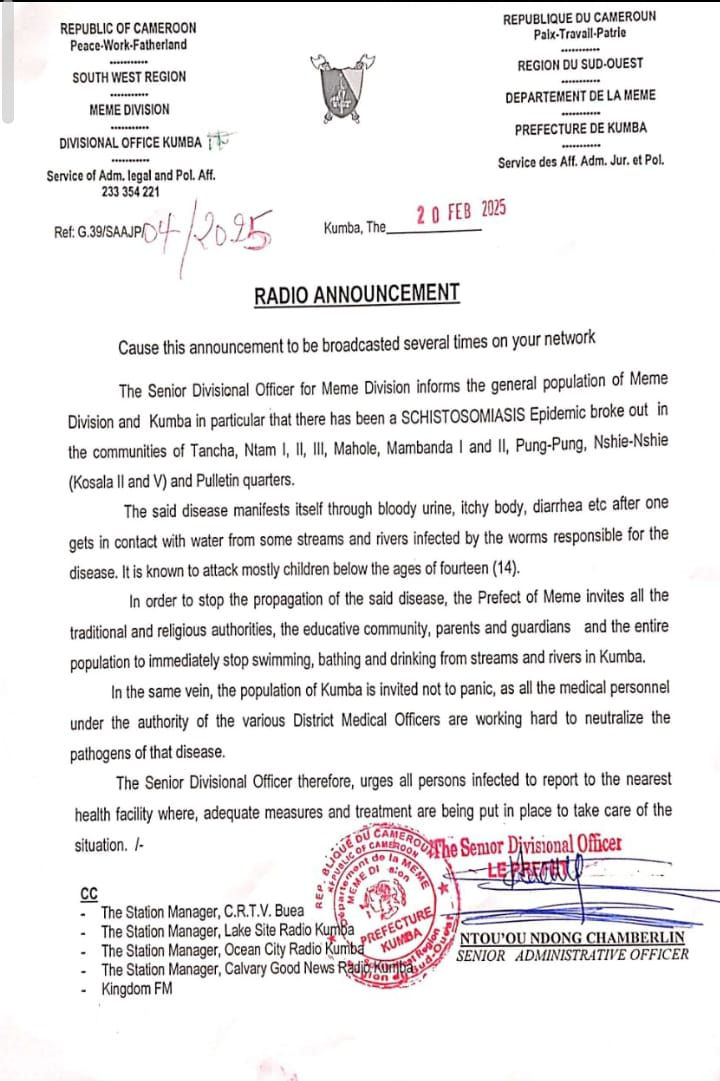Schistosomiasis Outbreak in Meme Division: A Call for Urgent Action and Better Health Communication
- Nkengacha M.Agendia
- Feb 22
- 4 min read

A recent announcement from the Senior Divisional Officer (SDO) of Meme Division has revealed an outbreak of schistosomiasis in Kumba and surrounding communities. The affected areas include Tancha, Ntam I, II, III, Mahole, Mambanda I & II, Pung-Pung, Nshie-Nshie (Kosala II & V), and Pulletin quarters. While HELP Foundation welcomes the announcement, it is concerning that health professionals and regional health authorities have remained silent, leaving the communication to an administrative officer. This raises questions about the credibility of the message and whether the public will take the necessary precautions seriously.
What is Schistosomiasis?
Schistosomiasis, also known as bilharzia, is a parasitic disease caused by flatworms (schistosomes). It is contracted when people come into contact with freshwater infested with the parasite’s larvae, which are released by infected snails. Once in the human body, the larvae mature into adult worms and cause severe damage to internal organs. The disease is prevalent in areas with poor sanitation and limited access to clean water.
How is Schistosomiasis Contracted?
The parasite enters the body when individuals wade, bathe, swim, or drink from contaminated freshwater sources such as rivers and streams. The larvae penetrate the skin and enter the bloodstream, where they migrate to various organs, primarily the bladder and intestines. In Kumba, the reported outbreak is linked to exposure to infected streams and rivers.
Click here for complete Life Cycle
Schistosomiasis is contracted when individuals come into contact with freshwater sources contaminated with parasitic larvae. The transmission follows a distinct life cycle:
Egg Release – Infected individuals excrete parasite eggs through urine or feces into freshwater sources.
Hatching and Snail Infection – The eggs hatch into free-swimming larvae called miracidia, which then infect specific freshwater snail species.
Larval Multiplication – Inside the snails, the parasites multiply and develop into another free-swimming larval stage called cercariae.
Human Infection – Cercariae are released into the water and penetrate human skin upon contact (e.g., swimming, bathing, or washing in contaminated water).
Maturation in the Body – The larvae enter the bloodstream, travel to the liver, and mature into adult worms. These worms then migrate to the bladder or intestines, where they lay eggs, completing the cycle.

This continuous cycle ensures the persistence of schistosomiasis in areas with poor sanitation and limited access to clean water.
Signs and Symptoms of Schistosomiasis
Schistosomiasis manifests through various symptoms, including:
Bloody urine (a key indicator of urinary schistosomiasis)
Itchy skin and rashes
Abdominal pain and diarrhea
Fatigue and general body weakness
Enlarged liver or spleen in severe cases
In children, it can lead to growth stunting and cognitive impairment
Diagnosis of Schistosomiasis
The disease is diagnosed through:
Microscopic examination of urine or stool samples to detect parasite eggs
Serological tests to detect antibodies or antigens in the blood
Ultrasound or imaging tests in cases of advanced infection affecting the liver or bladder
Treatment of Schistosomiasis
The primary treatment for schistosomiasis is Praziquantel, an effective anti-parasitic drug that kills adult worms. Treatment is most effective when administered early, preventing complications like organ damage. The WHO recommends mass drug administration in high-risk communities to reduce transmission.
Prevention of Schistosomiasis
Schistosomiasis can be prevented at various levels:
1. Individual Prevention Measures:
Avoid swimming, bathing, or washing in untreated freshwater sources.
Avoid consuming raw or undercooked snails, slugs, or other contaminated sources such as unwashed vegetables and water.
Drink only clean, treated, or boiled water.
Wear protective clothing (boots, gloves) if contact with infected water is unavoidable.
2. Community-Based Prevention Measures:
Improve sanitation by constructing proper latrines and preventing open defecation.
Organize health education campaigns on schistosomiasis transmission and prevention.
Implement community-based mass treatment programs.
3. Government and Health Authorities’ Role:
Provide clean and safe drinking water to communities.
Conduct regular environmental assessments and snail control measures.
Implement preventive chemotherapy programs to curb the spread of the disease.
The Communication Gap: A Major Setback
One alarming aspect of this outbreak is the lack of communication from health professionals and regional health authorities. Instead of expert-led public health awareness, the SDO—a government administrator with no medical expertise—was the sole source of information. This undermines the credibility of the message and may lead to low adherence to preventive measures.
Health crises require clear, science-backed communication from medical professionals to build public trust and ensure compliance with health directives. When expert voices are missing, misinformation and skepticism thrive, making disease control efforts less effective. A clear example is the ommission of an important source of contracting the disease in the communique by the SDO, which is eating raw or undercooked snails, slugs, or other contaminated sources like unwashed vegetables and water - a detail that a health expert will not overlook, especially since snails are widely consumed in the affected areas.
SDO's Communique

The schistosomiasis outbreak in Meme Division highlights the urgent need for public health intervention, proper sanitation, and responsible communication from health authorities. While the SDO’s announcement is a step in the right direction, the silence of health professionals is worrisome. For effective disease control, credible voices—doctors, epidemiologists, and public health officials—must lead the response. Authorities must prioritize consistent, expert-driven health messaging to ensure community cooperation and protect public health.


Thank you so much for this expert write-up meant for educational purposes and correction of some lapses on the part of the health authorities,this will go a long way to reawaken those concerned to take quick action